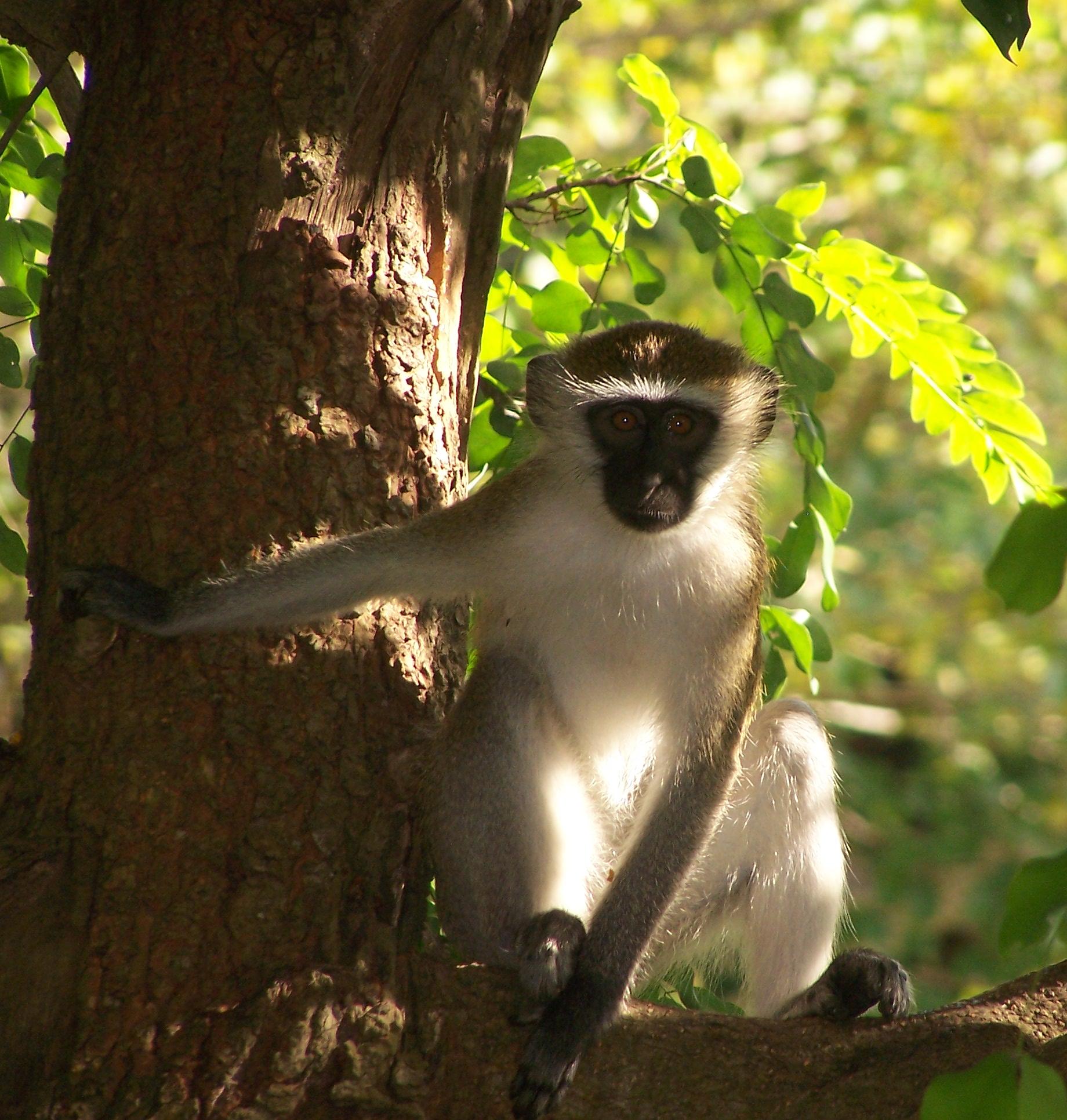- Vervet Monkey
Taxobox
name = Vervet MonkeyMSW3 Groves|pages=159|id=12100508]
status = LC
status_system = iucn3.1

regnum =Animal ia
phylum =Chordata
classis =Mammal ia
ordo =Primate s
familia =Cercopithecidae
genus = "Chlorocebus "
species = "C. pygerythrus"
binomial = "Chlorocebus pygerythrus"
binomial_authority = Linnaeus, 1758The Vervet Monkey, sometimes simply known as the Vervet, is the
common name of thespecies "Chlorocebus pygerythrus", anOld World monkey in the familyCercopithecidae . (The common term "vervet" is also sometimes used to refer to all the members of the genus "Chlorocebus ".)The Vervet Monkey ranges throughout much of Southern and
East Africa , being found fromEthiopia andSomalia south toSouth Africa . It is not found west of theGreat Rift Valley orLuangwa River , where replaced by the closely relatedMalbrouck ("C. cynosuros"). The two have often been consideredconspecific , or consideredsubspecies of a widespread "C. aethiops". [cite book |author=Kingdon, J. |year=1997 |title=The Kingdon Guide to African Mammals |publisher=Academic Press Limited, London |isbn=0-12-408355-2] The Vervet Monkey inhabitssavanna lands and mountains up to 4,000 m (13,100 ft).Description
Males vary in size from 45 to 85 cm (18-34 in), and weigh between 3.5 to 7.5 kg (7.5-16.5 lb), while females, range from 40 to 60 cm (16-24 in) in size and between 2.5 to 5.5 kg (5.5-12 lb) in weight. Both have tail lengths that can vary from 50 to 115 cm. The pigmentation of the male Vervet Monkey's
scrotum is a vivid blue that pales when the animal falls in social rank. The hydration of the scrotal skin controls its color. [cite journal | title = Control of scrotal colour in the vervet monkey | author = Price, J.S., Burton, J.L., Shuster, S. & Wolff, K. | journal = J Med Primatol. | year = 1976 | volume = 5 | issue = 5 | pages = 296–304 | url = http://www.ncbi.nlm.nih.gov/sites/entrez?cmd=Retrieve&db=PubMed&list_uids=828671&dopt=Citation]Behavior
The Vervet Monkey is mainly
frugivorous , but it also supplements its diet with a variety of other foods, including leaves, seeds, insects and small rodents. It has been known to destroycrops inKenya , [cite web |author=Njeri, J. |url=http://news.bbc.co.uk/1/hi/world/africa/6959209.stm |publisher=BBC |title=Monkey misery for Kenyan women villagers |date=2007-08-24 |accessdate=2008-07-13] and was classified as avermin in South Africa, allowing it to be shot without previously obtaining a permit, up until 2003. [cite web |author=Barrett, A. S. |year=2005 |url=http://etd.unisa.ac.za/ETD-db/theses/available/etd-04212006-150228/unrestricted/00dissertation.pdf |title=Foraging behavior of the Vervet Monkey (Chlorocebus aethiops) in mixed bushveld and sour lowveld bushveld of the Blydenberg Conservancy, Northern Province, South Africa| pages=141 |accessdate=2008-07-12]It commonly lives in groups or "troops" of 20 or more, however the size of the group is often smaller than 20. Its gestation period is 7 months with a single offspring produced and is known to have a life span of up to 20 years.
One interesting phenomenon about the Vervet Monkey is that it seems to possess what has been called the "rudiments of language".Fact|date=June 2008 Vervet Monkey alarm calls vary greatly depending on the different types of threats to the community. There are distinct calls to warn of invading leopards, snakes, and eagles. In doing so they attract attention to themselves, increasing their personal chance of being attacked, this has been noted as altruistic behaviour. [cite book | author=Cheney, D. L. & Seyfarth, R. M. | year=1990 | url=http://books.google.co.uk/books?id=QbWTd85eHUgC | title=How monkeys see the world: Inside the mind of another species | publisher=University of Chicago Press]
Classification
There are five distinct subspecies of Vervet Monkeys:
* "Chlorocebus pygerythrus hilgerti"
* "Chlorocebus pygerythrus excubitor"
* "Chlorocebus pygerythrus nesiotes"
* "Chlorocebus pygerythrus rufoviridis"
* "Chlorocebus pygerythrus pygerythrus"In ancient history
This species was known in ancient
Egypt including theRed Sea Mountains and theNile Valley . [cite journal |author=Moeyersons, J., Vermeersch, P. M., Beeckman, H. & Van Peer, P. |title=Holocene environmental changes in the Gebel Umm Hammad, Eastern Desert, Egypt: Dry cave deposits and their palaeoenvironmental significance during the last 115 ka, Sodmein Cave, Red Sea Mountains, Egypt |journal=Geomorphology |volume=26 |issue=4 |year=1999 |pages=297–312 |doi=10.1016/S0169-555X(98)00067-1] Fromfresco artworks found inAkrotiri on the Mediterranean island ofSantorini there is evidence that the Vervet Monkey was known to the inhabitants of this settlement around 2000BC ; this fact is most noted for evidence of early contact between Egypt and Akrotiri. [cite web |url=http://themodernantiquarian.com/site/10846/akrotiri.html#fieldnotes |author=Michael Hogan, C. |date=2007-12-13 |title=Akrotiri |publisher=Modern Antiquarian |accessdate=2008-07-13]References
External links
* [http://www.enviro.co.za/vervet/ Vervet Monkey Foundation]
* [http://www.wjh.harvard.edu/~mnkylab/media/vervetcalls.html Vervet Monkey calls]
* [http://news.bbc.co.uk/2/hi/africa/6959209.stm BBC story: Vervet Monkeys raid farms]
Wikimedia Foundation. 2010.
